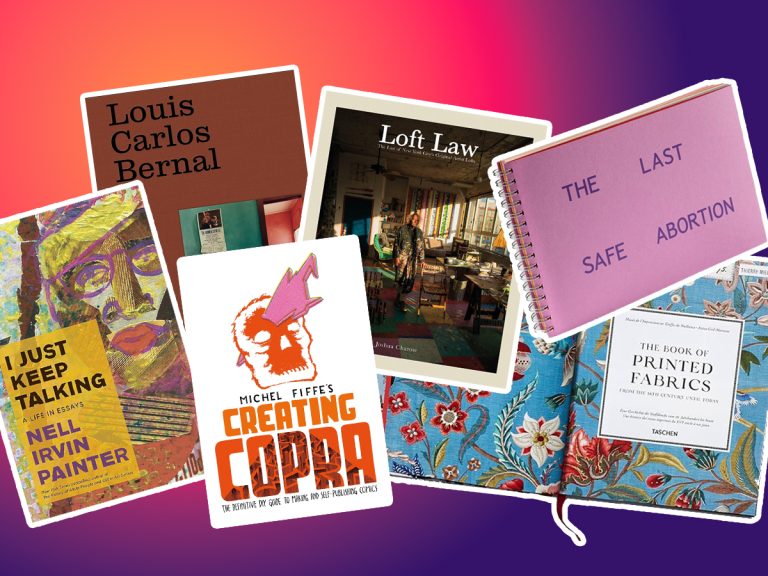If you’ve been having trouble doing anything but basking in an air-conditioned room or cooling center this summer, let alone picking up a thick book, know that you’re not alone. Our editors and contributors have compiled a list of short, enjoyable books that will either pull you out of your reading slump this month or save for future reading. Our picks include photography from a Manhattan artist’s loft, fascinating essays by scholar Nell Irvin Painter that blend the historical and the personal, and even a how-to manual for aspiring cartoonists. Enjoy, and stay cool! —Lakshmi Rivera Amin, Associate Editor
Luis Carlos Bernal: Monographs

Louis Carlos Bernal captured the simultaneous waves of vulnerability and resistance in Mexican-American communities in the Southwest and beyond with his stirring photographs. This book, the first major monograph of the late pioneering Chicano photographer, coincides with a traveling exhibition at the University of Arizona’s Center for Creative Photography. Whether depicting families in intimate domestic settings or documenting the living conditions of farm workers in California, Bernal found a way to center his subjects’ individuality while affirming his own values—what curator Elizabeth Ferrer describes as the “Chicano imagination” in her outstanding essay for the publication.Valentina di Licia
Buy in the bookstore | Aperture, June 2024
Loft Rules: New York City’s Last Original Artist Loft By Joshua Charow

When the streets of Soho weren’t yet home to influencers and blue-chip galleries weren’t vying for real estate in Tribeca, New York City’s lofts were living spaces and studios for artists, who purchased the soaring ceilings and giant windows of these former factories and warehouses at today’s bargain prices. Countless were eventually forced to move or evicted as landlords demanded higher rents for space in commercial districts. When Joshua Charow stumbled across a map of buildings protected by the “Loft Law,” he felt compelled to meet and photograph the tenants who still lived in the mysterious “artist lofts.” Step into the homes of experimental filmmaker Ken Jacobs, painter Kimiko Fujimura, and many others with this very special book that isn’t exactly a portal to the past, but a living archive of an enduring phenomenon. —STDs
Buy in the bookstore | Damiani Books, April 2024
The last safe abortion By Carmen Winant

One of the highlights of this year’s Whitney Biennial was Carmen Winant’s collage, The Last Safe Abortion (2023), which consists of 2,500 prints. Yet at this scale, it can be difficult to comprehend the seriousness and importance of the work, let alone the individuals featured in the images. A recently published book about the project addresses this question and is both informative and engaging. While the artist’s text provides helpful context, the book is really about the thousands of archival photographs of abortion care workers, patients, and advocates taken by Winant and others. The publication provides time and space to observe the people in the photographs, to think about their lives and situations, and to feel a sense of connection that is rarely seen in a white cube museum. It gives the subjects of the photographs the respect they deserve. —Natalie Haddad
Buy this book | Mack Books, April 2024
Continue: Prose Life By Nell Irvin Painter

Historian Nell Irving Paynter’s collection of essays opens with two self-portraits in the foreword: one a collage, the other a skeleton drawing, which she calls “a warning against excessive self-esteem (oddly for someone who has painted dozens of self-portraits).” It’s a treat to read her sharp essays culled from decades of reporting and writing, with her own lithographs, drawings, collages, and paintings dotting the text. Her exceptional scholarship on the American South and whiteness features prominently in the book. I just keep sayingand other essays on life and art. The artist reflects on Alma Thomas and the process of aging, her experience attending art school while writing a book, the lack of recognition for black women artists, and more, all together painting a vivid portrait of her multifaceted lifelong pursuits.this
Buy in the bookstore | Doubleday Books, April 2024
The Book of Printed Fabrics: From the 16th Century to the Present By Aziza Greer Marriott

Calico first arrived in Europe from India in the late 16th century, and the lightweight, brightly coloured material soon appeared on clothing, furniture, wall hangings and many household textiles. Over the past 500 years, calico has had a huge impact not only on Western fashion, but also on its industry, technology and culture. This was particularly true in France, where calico caused such a sensation that it was banned in the mid-17th century but later flourished through renowned manufacturers in Normandy and Alsace, and later in the boutiques of Paris. A two-volume work by art historian Aziza Gril-Mariotte The Book of Printed Fabrics: From the 16th Century to the Present Through the nearly 900 printed fabric samples in the Etophis Museum’s collection, the story of this key material is told, from woodcuts to digital printing methods using natural and chemical dyes. These diverse and beautifully reproduced designs are a joy to behold and their extensive history to ponder. —Lauren Moya Ford
Buy in the Bookshop | Bags, April 2024
Making Coconut By Michel Fiffe

Superhero comics released in 2012 Coconut By Michel Fiffe Both Parodies of 1980s superhero comics and A unique book with unusual design elements. Fiffe’s most recent self-published book, Making CoconutWith 12 years of experience in self-publishing in various formats, He elaborates on how he handles these formal elements, from Recognition standards and expectations Break his choice, either persist or subvert.
Despite the influence of instruction manuals and the comic book back cover industry, Making Coconut Unlike other “how-to” books and guides for comic artists, Feifei is able to weave her own personal story into her instruction. In 64 pages, the book captures an arc that highlights the emotional rollercoaster of creating art. and sales, and perfectly depicts how he handles the complex relationship between himself and his audience.Campbell
Buy this book | February 2024

